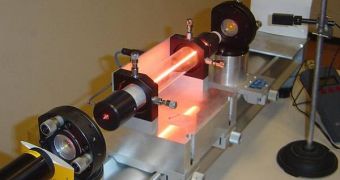Regularly, for calibrating underwater devices such as sonars and communication arrays, engineers need to generate some noise at a distant location, and then fine-tune their instruments to that specific noise. But generating the sound is a fairly complex process, which is about to be made a whole lot simpler through the use of lasers. Acoustics, optics and fluid dynamics experts have learned that the stimulated light can easily generate extremely large amounts of noise with relative ease, especially if pulse lasers of different colors are used in the process.
Basically, scientists are currently trying to convert light into sound, by using nothing more than lasers and water. According to the theory, when laser pulses of different colors hit a body of water, they can self-compress, and super-heat a small volume of the liquid, mostly because different light wavelengths within the laser travel at different speeds through it. This creates friction, which, in turn, generates heat. The expansion of these volumes of water triggers sonic shock waves through it that have been measured to be as high as 210 decibels, well above the tolerable limit for the human ears.
Behind a bid to apply this new technology in testing facilities is a team of experts from the US Naval Research Laboratory in Washington, DC, led by physicist Ted Jones. The scientists are currently working on devising the best way of combining visible light and infrared lasers in a single beam, so that the effect on the water could be even more percussive, ScienceDaily reports. In addition, they are also contemplating the possibility of having the laser generators installed in planes, which would basically eliminate the need of installing a piece of hardware in the water and then maneuvering the craft away from it, while calibrating listening instruments and sonars.
The team have also enumerated a host of other applications for their innovation, including the development of an airplane-to-submarine communication system, which would make use of the fact that lasers can penetrate miles and miles of atmospheric air and also a good distance under the waves. In the future, the experts even envision employing the system to map the bottom of the ocean, by devising a way to listen to the acoustic “pings” each of the laser pulses makes when hitting the ocean floor. Naturally, this could also be done to scout for mines, if the experts manage to refine the existing lasers to a far greater extent.

 14 DAY TRIAL //
14 DAY TRIAL //